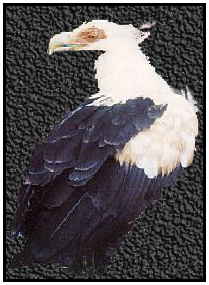Palm-NutOrder: Falconiformes. Palm-Nut Vulture Stamp (Copyright ©2000)Family: Accipitridae. (Old World vulture). Scientific Name: Gypohierax angolensis. Common Names: Palm-nut Vulture or Vulturine Fish Eagle. Conservation Status: Rare. Rescue & Recovery: None. Geographical Range: Africa, south of the Sahara. Its distribution coincides almost precisely with the main growing areas of its favourite food, the oil palm. Habitat: Woodland Savannahs, particularly oil-palm groves. Physical
Characteristics: The Palm-nut Vulture
resembles both vultures and sea eagles with some experts Palm-Nut Vulture Stamp (Copyright ©2000)believing it to be a link between the two (occasional confused with the African Fish Eagle). It can weigh in at up to 1.7 kgs with a wingspan of 1.5 metres. This bird is incapable of sustained flight and due to its limited abilities in this area it spends much of its time on palm trees at rest. Birds are mostly white with black on the secondary feathers and black tips on the primaries. The tail is also black, but with a white band. Bare skin on the face and feet varies between yellow and orange, while the iris is yellow and the cere grey. Males are slightly smaller than females. It takes three years for a young Palm-nut Vulture to gain its full adult colouring and until this time it will be varying shades of brown, with black primary feathers. The Palm-nut Vulture has several high-pitched, whistling calls used during copulation or territory defence; it can also produce a quacking similar to that of a duck.Food: Though this bird only has a very small territory, it is not necessary for there to be a water supply nearby as the birds obtain liquid from the fruit of oil-palm, which also provides their primary food. Basically a vegetarian bird of prey which commonly rejects meat in favour of the oil-palm husk. It will also catch locusts, crabs, snails, molluscs, and even stranded fish; has occasionally been known to take domestic poultry.
Palm-Nut Vulture (Copyright ©2000)Reproduction: When the breeding season starts the Palm-nut Vulture pairs off and goes to nest, usually in the same place each year. Their preferred nesting sites are tall trees, 10 -- 50 metres above the ground. Nests are built using palm leaves and are about one metre across. Both partners assist in building the nest and it takes the pair about a month to complete the job. If an old nest remains from previous years they may simply choose to repair that. The female lays a single white egg with dark brown specks, then incubates it for 44 days. Both parents feed the young until the depart the nest at around 100 days, still clothed in their dark infant plumage.
|



